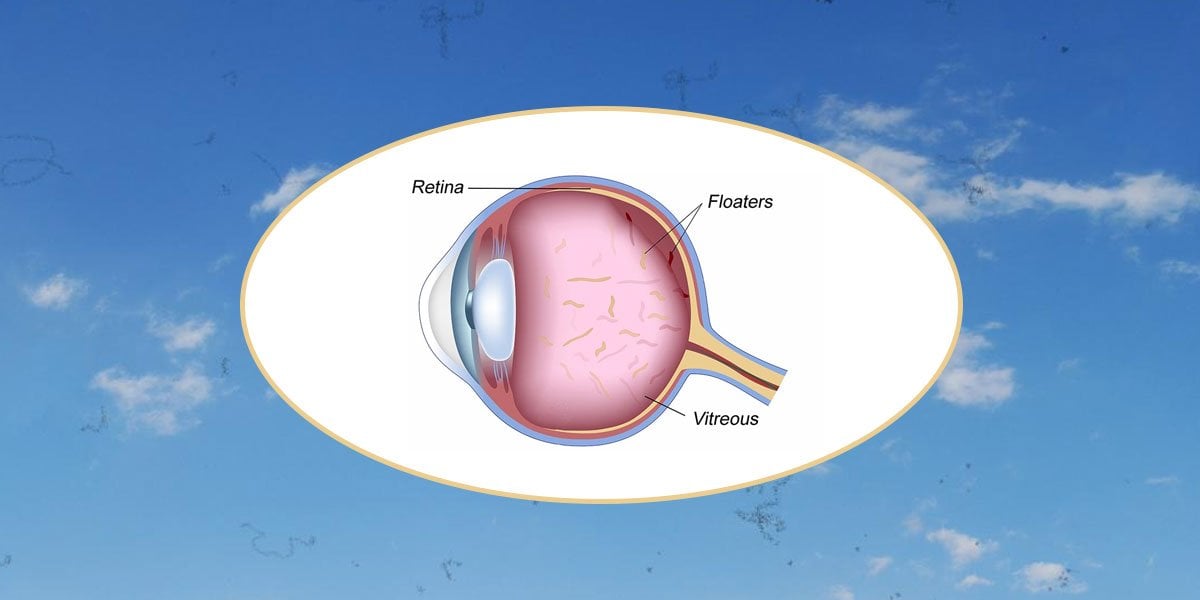Are Eye Floaters Normal? Here’s What You Need to Know

Are you seeing black or gray spots and specks in your vision? These are most commonly known as eye floaters. Varying in shape and size, you may see a single floater or many. They seem to drift about and dart away when attempting to see them directly. Floaters may be more prevalent in one eye than the other and more noticeable under certain light conditions like the bright sky or a light background on a computer screen.
Most often, floaters are age-related.
After the age of 50, the natural development of floaters can occur. The eyeball is filled with a protein and water jelly-like substance called the vitreous. The vitreous forms and maintains the round shape of the eyeball. Over time, this substance begins to change, partially becoming more liquid.
As the vitreous shrinks from this natural shift in structure, it can tug on the retina and pull away. The protein fibers loosen, clump and float in the liquid of the eye. These specks, threads and cobweb-like shapes block the light from the retina. It is these shadows of blocked light that cause the floaters to be seen. Called a posterior vitreous detachment, this form of detachment is common and doesn’t threaten vision.
Other causes
Floaters can also be a painless symptom of other eye conditions. Any cellular material within the vitreous can cause floaters. Other causes include:
- Nearsightedness
- Eye trauma
- Complications from eye surgery
- Diabetic retinopathy
- Eye inflammation
- Injected eye medications
- A torn retina
Warning signs
In about 1 in 6 people, a posterior vitreous detachment causes a tear in the retina. Although a retinal tear is painless, other symptoms can indicate this condition. It is important to contact an eye specialist immediately at the first sign of symptoms to minimize any damage caused by the condition. Should these sudden changes in vision and eye floaters occur, contact your doctor as soon as possible. Warning signs include:
- A sudden increase in the number of floaters
- Light flashes, similar to lightning strikes
- Gradual shading or loss of peripheral vision
- A blind spot or rapid decline in central vision
Retina tear
A retinal tear leaves the retina unprotected and can lead to a more serious condition called retinal detachment. If untreated, the tear can allow fluid to seep in, causing the retina to separate from the tissues that nourish it and lead to permanent vision loss.
Early detection and timely treatment of a retinal tear can often prevent retinal detachment and decrease the risks of loss in vision. Treating a retinal tear is a relatively easy laser procedure that is done in the office. The laser prevents progression to a retinal detachment.
Retinal detachment
Retinal detachment is a very serious eye condition. Without prompt and proper treatment, permanent vision loss can occur. The sooner the retina can be reattached, the more effective treatment tends to be.
Pneumatic retinopexy or laser photocoagulation are procedures that can preserve vision in many and may allow the return of vision in some patients. However, most patients require surgery which can be difficult. Sometimes a gas bubble needs to be placed in the eye and it may be necessary to do head positioning after the surgery for a few weeks.
Vitreous hemorrhage treatment
Diseases such as diabetic retinopathy can lead to the development of new blood vessels to grow within the vitreous. A vitreous hemorrhage occurs when one of these new blood vessels ruptures and bleeding occurs. Severe bleeding can increase the number and size of floaters and cause blurry, cloudy or hazy vision. Treatment for vitreous hemorrhage may include vitrectomy surgery, cryotherapy, laser photocoagulation, or intravitreal injections.
Yag laser treatment for floaters
As floaters are common with age, once it is determined these floaters are not the cause of any further damage, most patients are counseled to learn to live with them. However, often times these floaters can be bothersome and cause difficulty reading, driving or using the computer.
Fortunately, VRC offers an effective and safe way to treat floaters using a Yag laser. A Yag laser will vaporize pesky floaters making them smaller or disappear altogether. Done as an outpatient procedure, you can return home and expect a full recovery within 24 hours.
Maintaining healthy vision is important to a healthy lifestyle. VRC provides the most state-of-the-art retinal treatments with a specialized staff trained to provide the best diagnostic and treatments available.
This content was reviewed by Dr. Pamela Ann Weber


